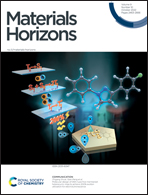Unprecedented toughness in transparent, luminescent, self-healing polymers enabled via hierarchical rigid domain design†
Abstract
The preparation of luminescent self-healing materials simultaneously featuring superior integrated mechanical properties is still a great challenge because the relationship between self-healing ability and mechanical capacities is conflicted. Here, transparent luminescent materials with balanced self-healing behavior, extreme toughness, and fast elastic recovery are prepared via hierarchical rigid domain design by coordinating lanthanide (Ln3+) to terpyridine (TPy) moieties linked to the polymer chains formed through polymerization of tolylene-2,4-diisocyanate-terminated polypropylene glycol (PPG-NCO) and 1,6-hexanediamine (HDA). The hierarchical rigid domain containing lanthanide–terpyridine (Ln3+–TPy) coordination interactions and H-bonds formed by urea and urethane leads to a tough network that features unprecedented toughness of 133.35 MJ m−3, which reaches 83% of that of typical spider silk (≈ 160 MJ m−3) and is also dynamic for fast self-healing at ambient temperature. Besides, the multi-color emission, ranging from red through orange and yellow to green, can be achieved via adjusting the molar ratio of Eu3+/Tb3+. We believe that the strategy applied in this work provides some insights for the preparation of high mechanical strength luminescence materials with self-healing properties.



 Please wait while we load your content...
Please wait while we load your content...